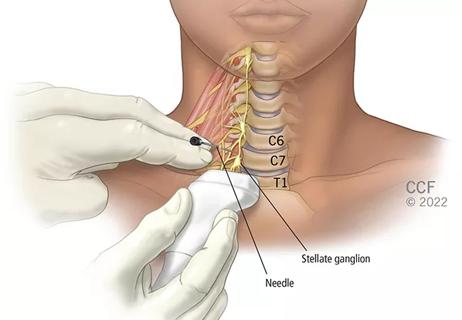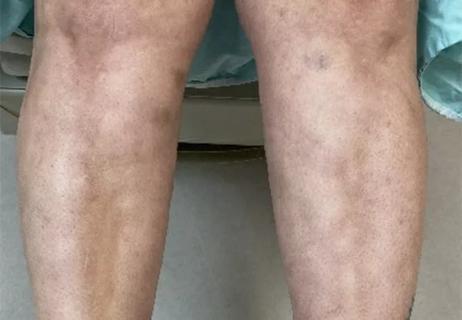In a global healthcare system, nursing steps up to meet demands

2020 was a year of unprecedented change and accomplishment in healthcare – and one of heartache and challenges. As COVID-10 began to come to light in January, nurses around the globe were called to duty.
Advertisement
Cleveland Clinic is a non-profit academic medical center. Advertising on our site helps support our mission. We do not endorse non-Cleveland Clinic products or services. Policy
Cleveland Clinic nurses, as part of a global healthcare system, were involved in every aspect of the health system’s response to the worldwide pandemic. It started with drive-through COVID testing and cross-training of nurses to meet patient needs. Soon, nurse leaders were developing a new surge hospital on Cleveland Clinic’s main campus. Cleveland Clinic nurses reached out to local and distant communities to show support, meet supply and equipment needs, and provide medical and nursing care to hospitals that required added personnel.
“During the Year of the Nurse, it has truly been remarkable how our nursing teams have come together and led with empathy, compassion and integrity during this pandemic,” says Meredith Foxx, MBA, MSN, APRN, PCNS-BC, PPCNP-BC, CPON, Executive Chief Nursing Officer of Cleveland Clinic. “I have witnessed Cleveland Clinic nurses at their highest level of professionalism.”
At Cleveland Clinic, one display of remarkable professional collaboration occurred when the Office of Nursing Education and Professional Development launched an immersive clinical training experience for ambulatory and perioperative nurses. The goal was to prepare them to assist in critical and acute care settings if and when a surge happened. Educators included nursing professional development specialists, clinical nurse specialists, members of the simulation team and members of the American Heart Association resuscitation team.
With more than 6,000 Cleveland Clinic nursing caregivers needing training in a very short amount of time, Education and Professional Development Associate Chief Nursing Officer Joan Kavanagh, PhD, RN, NEA-BC, FAAN, reached out to deans and directors of Northeast Ohio schools of nursing to help cross-train.
Advertisement
“Although we had a village of great educators, the Nursing Education leadership team soon realized we needed more help – and we needed help that would be meaningful and from experts in education,” says Kavanagh. “So we turned to our academic partners at Northeast Ohio’s schools of nursing in hopes of creating a unique academic-practice partnership.” More than 20 faculty helped provide education throughout the 11 weeks Cleveland Clinic held the training.
The training featured experiential, engaging learning sessions in a simulation laboratory setting using patient manikins, ventilators, chest and IV tubes, and more. Running 7 a.m. to 7 p.m., seven days a week, the courses were five to six hours in length and were offered in the morning, afternoon or on weekends at main campus and several ambulatory surgery centers that were closed at the time due to the virus. Skills that the participants learned included donning and doffing personal protective equipment, central line care, ventilator care, rapid sequence intubation, operation of mechanical compression devices, pronaton and codes for COVID-19 positive patients.
“The generosity of spirit from Cleveland Clinic’s partners in academia – giving of their time and talents as they were able – was extremely commendable and appreciated,” says Kavanagh. “It was an incredible opportunity to work closely together with these trusted colleagues.”
Anticipating a swell of COVID-19 patients that might overwhelm area hospitals as the pandemic peaked in Northeast Ohio, Cleveland Clinic accomplished the daunting challenge of creating a 1,000-bed surge facility in a matter of weeks. By April, a multidisciplinary team had turned Cleveland Clinic’s state-of-the-art Health Education Campus into a site for COVID-19 patients that became known as Hope Hospital.
Advertisement
Shannon Pengel, MSN, RN, Chief Nursing Officer of Cleveland Clinic Main Campus, was part of the multidisciplinary team that developed clinical workflows, safety procedures and other guidelines so that caregivers could function seamlessly in an unfamiliar space. Team members met in the building’s whiteboard-equipped classrooms to map out the directives, then walked the soon-to-be treatment areas to verify their plans would work in real-world settings. They developed playbooks for all surge hospital personnel, describing everything from where and how to don personal protective equipment to the location of break areas. To aid navigation, the building was divided into color-coded units, just like a traditional hospital. In addition to hospital leadership, everyone from pharmacy to supply chain to laboratory medicine was involved.
“It was a true team of teams’ effort. We had to consider every patient interaction and how we could keep them safe and our caregivers safe,” says Pengel, who served as CNO of Hope Hospital. “It was intensive and included everything from getting a patient to the bathroom to planning emergency evacuations.”
Equally important to planning and preparing the physical space and adopting procedures was ramping up technology solutions. “Nurses were instrumental in collaborating with information technology, clinical engineering and third-party vendors in preparing and validating the technology required for Hope Hospital operations,” says Nelita Iuppa, DNP, MS, BSN, NEA-BC, RN-BC, FHIMSS, Associate Chief Nursing Officer of Informatics.
Advertisement
Solutions were divided into three categories: technology equipment and hardware for Hope Hospital caregivers, medical equipment and devices for technology infrastructure, and nursing-specific digital solutions. With the help of the nursing informatics team, more than a dozen technologies were validated, tested and stood up in Hope Hospital during a three-week period. These included a custom patient/nurse call light system, large-volume IV smart pumps, mobile medication dispensing cabinets, wireless communication devices and iPads for virtual family visits and private patient consultations with providers. In addition, the Office of Nursing Informatics coordinated virtual and socially-distant onboarding training on electronic medical record documentation and other building technologies for approximately 300 staff who were assigned to work at the new location.
Edmund Sabanegh, MD, President of Main Campus and Regional Hospitals, called the creation of Hope Hospital “a heroic effort by hundreds of people.” Fortunately, the expected surge did not happen in Cleveland, and the teams were able to decommission the hospital in August.
In the early days of the COVID-19 crisis, healthcare professionals across the globe united in an all-hands-on-deck fashion. When a call for help came in, the Cleveland Clinic nursing team, physicians and other caregivers stepped up to the plate.
In April, 15 Cleveland Clinic nurses volunteered to travel from Cleveland to various New York-Presbyterian Hospitals in New York City, and 13 nurses went to several Henry Ford Hospital locations in Michigan. They were there to provide much-needed relief to fellow nurses as COVID-19 was rapidly spreading throughout both states.
Advertisement
In May, 26 Cleveland Clinic nurses boarded a plane for Abu Dhabi in the United Arab Emirates. During the peak of the COVID-19 surge at Cleveland Clinic Abu Dhabi (CCAD), the hospital increased its intensive care bed capacity from 72 to 130, creating a staffing challenge. “For six weeks, these volunteers gave their time and provided expert contributions to help out not only our community and family here at CCAD, but the community of Abu Dhabi during our greatest time of need,” says Sue Behrens, DNP, RN, ACNS-BC, NEA-BC, Chief Nursing Officer of CCAD.
Together with Cleveland Clinic caregivers in Abu Dhabi, the Cleveland-based nurses shared their expertise and best practices and learned about Abu Dhabi’s program for treating patients. “Volunteering is rewarding but can also be a sacrifice,” acknowledges Behrens. “Words cannot express the act of kindness these caregivers provided, and I thank each of them for making the leap of faith and for making a difference. We wouldn’t have been able to provide the care we did without their help.”
Nursing leaders and clinical nurses back in Cleveland were instrumental in the cause too. The human resources team called all nurses who expressed an interest in volunteering and explained the assignments. They also vetted interested nurses to make sure they had the required experience in intensive care nursing. Next, the team considered staffing requirements at Cleveland Clinic.
“Once we identified nurses who were available and qualified to go, we had to determine if we could really let them go based on our needs here,” says Jill Prendergast, PHR, Senior Human Resource Director for the Nursing Institute. “We used our usual protocol on filling staffing gaps, including our internal float pool group and other ICU nurses who could pick up additional hours.”
Prendergast’s team organized a kickoff call for all nurses who were traveling to explain the logistics of travel, as well as the support they would receive from Cleveland Clinic. Each nurse had contact information from a human resources staff member in case they had questions while they were gone, and Terri Murray, MSN, RN, NEA-BC, Nursing Director for the Respiratory Institute, the Head & Neck Institute and Infectious Disease, Main Campus, kept in regular contact with the traveling nurses. In addition, the Office of Caregiver Experience supported the families of volunteer nurses while they were gone, touching base to see if they needed anything and delivering free meals to them.
The willingness of nurses to pull together during a pandemic and help one another – and patients – came as no surprise to K. Kelly Hancock, DNP, RN, NE-BC, FAAN, Chief Caregiver Office of Cleveland Clinic. “Nursing is a family and we are there for one another,” said Dr. Hancock during Cleveland Clinic’s virtual Nursing Excellence Awards event in September. “We were so proud to see the compassion and above-and-beyond dedication of our nurses who traveled to help colleagues and patients outside of their home cities.”
Advertisement

Patients report improved sense of smell and taste

Clinicians who are accustomed to uncertainty can do well by patients

Unique skin changes can occur after infection or vaccine

Cleveland Clinic analysis suggests that obtaining care for the virus might reveal a previously undiagnosed condition

As the pandemic evolves, rheumatologists must continue to be mindful of most vulnerable patients

Early results suggest positive outcomes from COVID-19 PrEP treatment

Could the virus have caused the condition or triggered previously undiagnosed disease?

Five categories of cutaneous abnormalities are associated with COVID-19